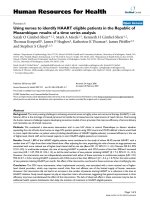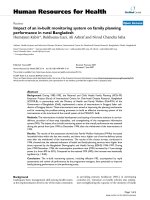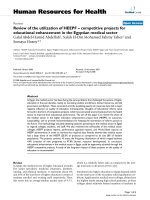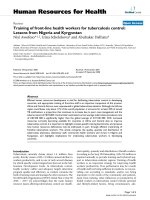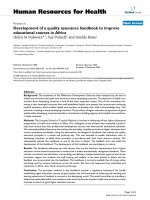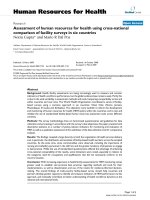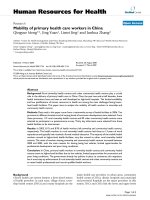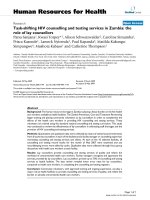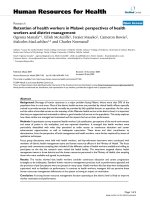Báo cáo sinh học: " Induction of Th1Immune responses following laser ablation in a murine model of colorectal liver metastase" potx
Bạn đang xem bản rút gọn của tài liệu. Xem và tải ngay bản đầy đủ của tài liệu tại đây (3.61 MB, 10 trang )
RESEARC H Open Access
Induction of Th1Immune responses following
laser ablation in a murine model of colorectal
liver metastases
Wen Xu Lin
†
, Theodora Fifis
*†
, Caterina Malcontenti-Wilson, Mehrdad Nikfarjam, Vijayaragavan Muralidharan,
Linh Nguyen and Christopher Christophi
Abstract
Background: Preliminary experimental studies have suggested that the in situ destruction of tumor tissue by local
laser ablation (LA) may also stimulate host immunity against cancer. We investigated local and systemic induction
of immune responses after laser ablation in the setting of residual tumor.
Methods: A murine colorectal cancer (CRC) liver metastasis model was used. Selected tumors of liver CRC bearing
mice and livers of mice without tumor induction were treated with LA. Liver and tumor tissues from the ablation
sites and from distant sites were collected at various time points following LA and changes in CD3+ T cells and
Kupffer cells (F4/80 marker) infiltration and the expression of interferon gamma (IFNg) were investigated by
immunohistochemistry and ELISpot. Base line levels of CD3+ T cells and Kupffer cells were established in untreated
mice.
Results: The presence of tumor induced significant accumulation of CD3+ T cells and Kupffer cells at the tumor-
host interface, within the tumor vascular lakes and increased their baseline concentration within the liver
parenchyma. LA of the liver induced accumulation of CD3+ T-cells and Kupffer cells at the site of injury and
systemic induction of immune responses as discerned by the presence of IFNg secreting splenocytes. LA of liver
tumors induced significant increase of CD3+ T-cells at site of injury, within normal liver parenchyma, and the
tumor-host interface of both ablated and distant tumors. In contrast Kupffer cells only accumulated in ablated
tumors and the liver parenchyma but not in distant tumors. IFNg expression increased significantly in ablated
tumors and showed an increasing trend in distant tumors.
Conclusion: Laser ablation in addition to local tumor destruction induces local and systemic Th1 type immune
responses which may play a significant role in inhibiting tumor recurrence from residual micrometastases or
circulating tumor cells.
Background
Colorectal ca ncer (CRC) is the most common solid
organ cancer across both genders and the third most
common cause of cancer related deaths [1]. More than
50% of patients with CRC develop liver metastases
(CRCLM) which is the leading cause of death in this
population. Surgical resection is the only potential cura-
tive option. The spatial distribution of metastases,
presence of extra hepatic disease, potential residual liver
volume and function as well as the general health of the
patient are the main factors that limit the surgical
option to approximately 10-25% of patients [2,3].
Advances in systemic therapies have progressively
increased the potential for surgical intervention by down
staging hepatic metastases in a small subset of patients
[4]. Despite successful surgery, the majority of patients
develop disease recurrence most frequently in the liver.
Local thermal ablation was developed to increase the
therapeutic options for patients with liver metastases
[5,6]. This involves the applicatio n of laser,
* Correspondence:
† Contributed equally
Department of Surgery, University of Melbourne, Austin Hospital, Heidelberg,
Australia
Lin et al. Journal of Translational Medicine 2011, 9:83
/>© 2011 Lin et al; licensee BioMed Central Ltd. This is an Open Access article distributed under the terms of the Creative Commons
Attribution License (http://creative commons.org/licenses/by/2.0), which permits unrestricted use, distribution, and reproduction in
any medium, provided the original work is properly cited.
radiofrequency or microwave energy to the tumor. The
particular energy in each case is c onverted into heat
that leads t o tumor destruction by coagulative necrosis.
The aim is to extend the necrosis into a rim of n ormal
tissue parenchyma surrounding the t umor for total
tumor destruction [7-9]. When applied as a minimally
invasive technique, thermal ablation has a number of
potential advantages including significantly lower mor-
bidity, minimal destruction of normal liver tissue a nd
transient changes in liver function enzymes, l eading to a
lesser regenerative response and the ability for repeated
application [10-13].
Early clinical comparisons between resection and ther-
mal ablation suggested that thermal ablation is asso-
ciated with a less favourable outcome [5]. Results from
experimental animal studies however suggest that ther-
mal ablation of metastatic liver tumors is associated
with reduced incidence of tumor growth and metastasis
compared to resection. Additionally a positive effect on
host immune response has been reported following ther-
mal ablation of tumors where the ablated tumor a nti-
gens appear to behave like a tumor vaccine [14-16].
This study investigated immune responses in mice
with CRC l iver metastases following LA of selected
tumors. In particular, it focused on changes of Kupffer
cells (or tumor infiltrating macrophages; TAMs) and
CD3+ T cells representing innate and adaptive immu-
nity respectively and on IFNg expression w hich is ass o-
ciated with Th1 pro tective immune responses in cancer
[17]. The experimental plan was designed to investigate
if protective immune responses occur in a scenario
reflecting clinical application of LA, where residual
micrometastases or tumor at the margins of a n ablation
site remain after treatment.
Methods
Animals
Six to eight week old male CBA mice (Laboratory Ani-
mal services, University of Adelaide, South Australia)
were used in all experiments. Mice were maintained in
standard cages with access to irradiated food and water
ad libitum, and exposed to a twelve hour light/dark
cycle. All procedures were implemented in accordance
with the guidelines of the Austin Health Animal Ethics
Committee.
Experimental model of CRC liver metastases
The primary cell line MoCR was derived from a
dimethyl hydrazine (DMH)-induced primary colon car-
cinoma in the CBA mouse and maintained in vivo by
serial passage in the flanks of CBA mice [18]. For pas-
sage and experimentation, tumors grown subcutaneously
were teased, passed through a filter, treated with EDTA
and washed in PBS to make a single cell suspension.
Liver metastases were induced by an intrasplenic injec-
tion of 5 × 10
4
tumor cells prior to splenectomy as
reported previously [18]. In this model, liver metastases
are f ully established by 2 1 days following tumor
induction.
Laser Ablation Treatment
Twenty-one days after tumor induction animals were
used for LA study. Similarly located intra-parenchymal
tumors of 7 mm diameter were chosen for s ub-total
laser ablation and was performed as described previously
[19]. Briefly a Neodymium Yttrium-Aluminium-Garnet
(Nd:YAG-wavelength of 1064 nm) laser (Dornier medi-
las fibertom 4100 Medizintechnik GmbH, Munchen)
was used. Animals were anaesthetized and a bilateral
sub-costal incision was performed to allow full exposure
of the liver. A 400 μm bare tip optical quartz fibre deliv-
ered laser energy, applying 100J of power per tumor (50
seconds at 2 Watts). The treatment parameters were
chosen based on our previous extensive studies where
the nature and extent of injury including temperature
profiles were examined [19-21]. Average tissue tempera-
tures reach 65°C adjacent to the fibre site without caus-
ing tissue charring. Higher power settings in this animal
model generally produce charring. This setting in tumor
tissue produces incomplete necrosis that does not
extend into the liver. For endpoints other than 0 t he
treated tumors were marked with spec ial dye (Davidson
Tissue Marking System, Bradley Products, Grale Scienti-
fic, Melbo urne, Australia), the abdomen was closed and
animals recovered.
Tissue Sample Collection
At each endpoint after LA treatment, mice were
anesthetized and their liver was excised. The two ablated
or sham treated (no activation of the probe) tumors
were identified and then immediately dissected from the
liver together with surrounding liver tissue. Samples of
liver tissue and untreated tumors were also collected.
All specimens were fixed in formalin for 48 hours and
processed for immunohistochemistry.
Experimental Design
Three study groups were used: The first study aimed to
establish the baseline distribution of T cells and Kupffer
cells in tumor bearing livers and consisted of two
groups of mice. The experimental group was induced
with metastatic tum or cells 21 days prior to tissue col-
lection and controls consisted of a group of mice from
the same cohort but not induced with tumor. The sec-
ond study investigated temporal changes in the distribu-
tion of T cells, Kupffer cells and IFNg expression, when
non tumor bearing animals were treated with TA in the
liver tissue and compared to b aseline controls (shams:
Lin et al. Journal of Translational Medicine 2011, 9:83
/>Page 2 of 10
liver not treated with TA). The third study investigated
temporal changes in the distribution of T cells, Kupffer
cells and IFNg expression in liver and metastatic tumor
tissues following TA treatment of two selected tumors.
The results were compared to baseline controls (day 21
post tumor induction and day 0 post TA treatment).
Immunohistochemistry
Formalin fixed paraffin embedded 4-μm-thick sections
of the tissues were deparaffinized and rehydrated using
standard techniques. Endogenous peroxidases were
blocked by incubation in 3% peroxide in methanol for
10 minutes. Antigen retrieval was achieved by incuba-
tion in Proteinase K in a 37°C oven for 20 minutes, fol-
lowed by a cooling down period of 10 minutes at room
temperature (RT). Normal goat serum (20%) was used
to block non specific binding. Commercially available
primary antibodies used for staining (CD3; rabbit anti-
human CD3+ polyclonal A0452, Dakocytomation, Den-
mark at 0.6 μg/ml, IFNg; rat anti-mouse IFNg monoclo-
nal 3321-3-1000, Mabtech, Australia, at 1 μg/ml,
Kupffer cell staining; rat anti mouse F4/80 monoclonal
antibody, ATCC no. HB-198, culture supernatant at
1:50 dilution). Negative controls were incubated with
the respective non immune antibody isotypes at the
same concentration as the primary antibody. Sections
were incubated with primary antibodies overnight at 4°
C. Sections treated with the rat antibodies were tre ated
with a rabbit anti-rat linker antibody before treatment
with a polymer based detection kit co ntaining goat anti-
rabbit immunoglobulins (IgG) linked to horseradish per-
oxidase (HRP) (Envision Plus, Dako, Australia). Each
incubation step was followed by two five minut e washes
with PBS + 0.05% Tween 20. Positive staining was visua-
lized using diaminobenzidine (DAB) as a substrate.
ELISpot assay
Mouse spleens were collected from LA treated and sham
LA treated mice and the spleen cells from each group
were pooled. Spleen cells (10
6
per well in 100 μLRPMI
complete medium) were incubated without stimulation for
18 h in 96-well plates (MAIPS; Millipore, Australia) pre-
coated with host species anti-murine IFNg (clone R4,
American Type Culture Collection, Manassas, VA). Tripli-
cate wells were set up for each condition. After washing
wells with PBS, secreted cytokine was detected with bioti-
nylated anti-murine IFNg (MAb XMG.21-biotin; Pharmin-
gen, Australia) followed by extravidin-alkaline phosphatase
at 100 μg/mL (Sigma). Spots of activity were detected with
a colorimetric alkaline phosphatase kit (Bio-Rad, Hercules,
California, USA) and counted using a plate reader (AID
GmbH, Germany) with AID ELISpot software Version 3.0.
Data are presented as mean spot-forming units (SFU) per
million cells ± standard error of the mean (SEM).
Quantification of CD3+ T cell and Kupffer cell staining
All sections were examined using a digital microscope sys-
tem (Coolscope, Nikon Corporation, Chiyokd-ku, Tokyo,
Japan). Areas of interest were identified and photomicro-
graphs for each region were captured for enumerat ion of
lymphocytes within (1) tumor-host interface (treated and
untreated distant tumors), (2) LA injury front and (3) dis-
tant normal liver away from the ablation sites. Images
were coded and analyzed using an image analysis program
in a blinded manner (Image-Pro Plus Version 4.5.1, Media
Cybernetics, USA). Counts were expressed as the number
of positive cells per mm
2
of tissue. Alternatively positive
stained areas were calculated using Image-Pro Plus soft-
ware and expressed as arbitrary units.
Semi-quantitative analysis of IFNg
Areas of interest were identified using a light microscope
(Olympus BH2, Japan) at a magnificatio n of 125x. The
entire margin of treated normal liver, tumor host inter-
face of treated/untreated tumor and normal liver tissue s
were examined. Scoring criteria was used to estimate the
amount and intensity of staining seen in each sample.
Thegradingsystemusedwas:as:0:nostaining1:faint
staining; 2: small amount or weak staining; 3: moderate
staining; 4: abundant or strong staining; 5: Abundant or
very strong staining. Means for each group were deter-
mined using the individual scores from each sample.
Statistical assessment
Statistical analyses were performed using SPSS program
(Statistical Package for the Social Sciences™, version 10,
Chicago, Illinois, USA). All data was expressed as the
mean ± standard error of the mean unless otherwise
specified. Data was tested for normality using detrend ed
Q-Q plots, descriptive statistics such as skewness and
kurtosis and the Kolgomorov-Smironov test prior to sta-
tistical analysis. Differences between groups were
assessed by non parametric Kruskall Wallis followed by
Mann Whitney U tests or parametric ANOVA follow ed
by Tukey post hoc analysis as appropriate. A P value of
0.05 or less was regarded as statistically significant.
Results
Tumor induces accumulation of CD3+ T cells and Kupffer
cells in liver and tumor tissues
The presence of liver metastases increased the concen-
tration of both CD3+ T cells and Kupffer cells in the
liver parenchyma as seen in Figure 1 (panels a and c
CD3+ immunostained sections, panels b and d F4/80
immunostained sections. Tumor bearing CD3+ cell
count; 85.2 ± 12.1 cell/mm
2
vs. naive 28.3 ± 2.8 cell/
mm
2
, P < 0.002 and Kupffer cell count; 673.1 ± 39.6
cell/mm
2
vs. naive 370.6 ± 10.6 cell/mm
2
, P < 0.00 03,
panels g and h respectively). Accumulation of both cell
Lin et al. Journal of Translational Medicine 2011, 9:83
/>Page 3 of 10
types was observed in the tumor tissues especially at the
tumor/host interface and within the vascular lakes (Fig-
ure 1 panel e f or CD3+ T cells and f for Kupf fer cells).
The concentration of both cell t ypes at the tumor host
interface were significantly higher than those in liver
parenchyma of naïve animals (Figure 1 panels g and h,
CD3+ cells; 402.2 ± 64.64.9 cell/mm
2
vs 28.3 ± 2.8 cell/
mm
2
, P = 0.003 and Kupffer cells: 975.6 ± 61.9 vs 370.2
± 10.6 cells/mm
2
, P < 0.0003) and also significantly
higher than the concentration in tumor bearing liver
parenchyma (Figure 1 panels g and h, CD3+ cells: 402.2
± 64.64.9 vs. 85.2 ± 12.1 cell/mm
2
, P < 0.003 and Kupf-
fer cells: 975.6 ± 61.9 vs 673.1 ± 39.6 cell/mm
2
,P<
0.0003). Therefore, these results show that tumor pre-
sence results in significant accumulation of CD3+ T
cells and Kupffer cells not only within the tumors but
also in the liver parenchyma.
Laser ablation of liver tissue induces local and systemic
immune responses
This study examined local and systemic immunological
effects of LA treatment on livers from animals with no
tumors. LA treatment resulted in the accumulation of
CD3+ T cells and Kupffer cells at the site of injury follow-
ing treatment compared to sham controls. (Figure 2 panels
a and e for CD3+ cells panels b and f for Kupffer cells).
CD3+ T cell accumulation at the injury site persisted over
the next three days with the peak occurring on day 2 fol-
low ing LA. (Figure 2g CD3+ increase compared to sham
treated liver. P values: Immediate: 0.068; day 1: 0.046; day
2: 0.053; day 3: 0.034, Mann Whitney U tests). In an earlier
study, we demonstrated that Kupffer cell accumulation
displayed a biphasic increase, with an initial peak followed
by a decrease over the next two days, and then another
peak at days three to five [19]. In this respect the Kupffer
cell kinetics were different to those of CD3+ T cells,
where a single peak was observed in the current study.
Increases in both Kupffer and CD3+ T cell concentration
after ablation were also observed within the distant unin-
jured parenchyma (Figure 2c and figure 2d respectively
and Additional file 1, Figure S1). LA treatment of the liver
also induced a systemic immune response. Significantly
greater number of splenocytes from treated animals
secreted IFNg at three days after LA treatment compared
to controls (Fi gure 2h; 23 5 ± 43.5 v s 106.3 ± 8.0 IFNg
secreting cells per million splenocytes respectively, P <
0.001). The se results represent in-vivo stimulation as the
splenocytes were not further stimulated during the ELI-
Spot assay, indicating that LA treatment induces immune
responses not only locally but also systemically even in the
absence of tumor.
Figure 1 Tumor i nduced accumulation of CD3+ T cells and
Kupffer cells. Liver sections from mice with CRC liver metastases
21 days post tumor induction (n >5) and from naive mice (n = 5)
were immunostained for Kupffer cells (F4/80 antibody) and CD3+ T
cells (anti-CD3+). Panels a and b: liver parenchyma from naïve mice
stained with anti-CD3+ and F4/80 respectively. Panels c and d: liver
parenchyma from tumor bearing mice stained with anti-CD3+ and
F4/80 respectively Panels e and f: tumor sections depicting the
tumor-liver parenchyma interface stained with anti-CD3+ and F4/80
respectively. Original magnification 200x Panels g and h:
concentration of CD3+ T cells and Kupffer cells expressed as mean
number of cells/mm
2
± SEM. 1, liver tissues from naïve animals; 2,
liver tissues from tumor induced animals; 3, tissues from tumor-liver
parenchyma interface. (CD3+ T; * P < 0.002 compared to naive, # P
= 0.003 compared to naive, + P < 0.003 compared to tumor
bearing liver.) (Kupffer cells; * P < 0.0003 compared to naive, # P <
0.0003 compared to naive, + P < 0.0003 compared to tumor
bearing liver.)
Figure 2 Immune responses following LA treatment of liver
tissue. Groups of mice (n >5) had LA treatment in the liver and
tissue was collected at various time points post ablation as
indicated. Control mice had sham LA performed (LA probe was not
activated). Panels a and b, sham treated liver sections at three days
post treatment. Panels c and d, liver sections distant from the site of
ablation at three days post treatment. Panels e and f, ablated liver
sections 3 days post treatment depicting the injury front. Original
magnification 200x. Panel g, temporal changes in CD3+ T cells at
the injury front following LA treatment expressed as mean number
of cells/mm
2
± SEM, * P < 0.05, compared to control. Panel h,
enumeration of IFNg secreting splenocytes at 3 days post liver LA
treatment, expressed as mean number of spots/million splenocytes
± SEM, ** P < 0.001, compared to control.
Lin et al. Journal of Translational Medicine 2011, 9:83
/>Page 4 of 10
Laser ablation of selected tumors induces concentration
and distribution changes of CD3+ T cells in tumor and
liver tissues
Changes in concentration and distribution of CD3+ T
cell s in tumor and l iver tissues (Figure 3a) following LA
of two tumo rs were investigated a t various t ime points
post treatment and compared to sham t reated mice.
Sham treatment did not significantly change the fre-
quency or distribution of CD3+ T cells in any of the
liver tissues compared to untreated animals. Further-
more there was no significant temporal change during
the different time points post sham treatment. In con-
trast, LA treatment produced an immediate increase in
CD3+ T cell c oncentration in the liver parenchyma
abovetheshamvalues(Figure3ecomparedtoFigure
3b). Immediate increases were also seen at the tumor
host interface of ablated and distant tumors, at the abla-
tion injury front and within vascular lakes of ablated
and distant tumors. These increases persisted at high
levels compared to shams at all time points (Figure 3
panels f-h for distant tumors and panels i-l for ablated
tumors). CD3+ T cells wer e not uniformly distributed
however, with patches of very high numbers observed at
the injury front (Figure 3 panels i and j) and at the
tumor host interface (Figure 3 panels k and l) while in
neighbouring regions accumul ation was a lot less preva-
lent. Similarly some vascular lakes within distant tumors
were observed to be densely populated with CD3+ T
cells while others were not. In general the most consis-
tent accumulation was observed at the tumor-host inter-
face of both ablated and distant tumors.
Temporal changes in CD3+ T cells at the tumor-host
interface of ablated and distant tumors were biphasic
with an initial rise followed by a small decrease and
then a second higher peak occurring between day 3 to 7
for both the ablated and dist ant tumor-host interface
(Figure 4). Infiltration of CD3+ T cells at the tumor
host int erface of LA treated tumors was increased at all
time points post treatment compared to sham operated
tumor-host interface (P values: 0.050; 0.061; 0.066;
0.050; 0.060 and 0.034; for time points 0,1,2,3,5 and 7
days respectively; Figure 4a. grey bars). Similarly infiltra-
tion of CD3+ T cells increased at tumor-host interface
in distant tumors of LA treated animals compared to
equivalent tissues of sham treated animals (P values:
0.119; 0.098; 0.026; 0.184; 0.000 and 0.003; for time
Figure 3 Changes in CD3+ T cell frequency and distribution following LA treatment of selected liver metastases. Groups of mice (n >5)
had two tumors LA treated and tissues were collected at various time points post ablation from areas indicated in the diagram of panel a.
Control mice had sham LA performed (LA probe was not activated). Panels b-d are CD3+ stained tissues from control animals; b liver
parenchyma, c tumor host interface and d an enlarged section of c as shown in the rectangle. Panel e depicts a section of liver parenchyma
from an LA treated animal immediately following ablation. Panels f-l are CD3+ stained tumor sections from LA treated animals collected at day 2
post treatment. Panels f and g depict CD3+ staining of a vascular lake in a distant tumor; g is an enlarged section of panel f as shown in the
rectangle. Panel h depicts a section of distant tumor host interface Panels i and j depict sections of the ablated tumor injury front. Panels k and l
depict sections of the ablated tumor host interface. Panels c, f and i original magnification 50x, all other panels original magnification 200x. L,
liver; T, tumor; N, necrotic tissue within the injury front.
Lin et al. Journal of Translational Medicine 2011, 9:83
/>Page 5 of 10
points 0, 1, 2, 3, 5 and 7 respectively; Figure 4a. white
bars).
Temporal biphasic changes of CD3+ T cell numbers
were seen wit hin the liver parenchyma distant from the
ablation sites Figure 4b. These changes showed an
immediate peak which was then followed by a second
peak, with significant differences seen in CD3+ T ce ll
numbers between the treated and sham groups (P
values: Immediate: 0.050, Day 1: 0.086; Day 2: 0.086;
Day 3: 0.043; Day 5: 0.008; Day 7: 0.433, t tests) after
LA treatment, suggesting systemic trafficking of these
cells.
Laser ablation of specific tumors induces increased IFNg
expression in tumor tissues
Tissues were collected as described in Figure 3a and
immunostaining for IFNg was performed. The expres-
sion of IFNg appears diffuse and generalised rather than
localised within cells and therefore a scoring technique
was used. Immediately following treatment, there was
increase in staining at the tumor host interface when
compared to sham treatment (Figure 5 a and 5b). Fol-
lowing LA treatment, IFNg expression over time dis-
played a biphasic pattern (Figure 5c) with an initial peak
at day 1 followed by a second peak between days 3 and
7 similar to that seen for CD3+ T cells (P values Day 0:
0.171, Day 1: 0.022; Day 2: 0.703; Day 3: 0.210; Day 5:
0.044;Day7:0.040,comparedtoshamtreated,Mann
Whitney U tests). IFNg expression also increased at dis-
tant tumor host interface; however the increases did not
reach significance levels (result not shown).
Changes in concentration and distribution of Kupffer cells
in tumor and liver tissues following laser ablation of
tumors
In a previous study we have shown that Kupffer cell
numbers significantly reduced at site of the tumor abla-
tion injury during the first tw o days following treatment
and then significantly increased, peaking on day 3 but
remaining significantly elevated compared to untreated
control for all further time points tested [19]. In the
present study we examined temporal changes of KC at
the margins of untreated tumors distant to the ablation
site. There was no significant difference between sham
ablated a nd ablated groups (Figure 6a), however signifi-
cant increases were seen in the liver parenchyma distant
to ablation site in the LA treated compared to sham
treated animals (Figure 6b), sugge sting systemic traffick-
ing of these cells.
Figure 4 Temporal changes in C D3+ T cells following LA
treatment of selected liver metastases. Groups of mice (n >5)
had two tumors LA treated and tissues were collected at various
time points post ablation. Control mice had sham LA performed (LA
probe was not activated). Panel a temporal changes in CD3+ T cells
at the tumor host interface; grey bars = LA treated tumors, white
bars = distant tumors and black bars = sham controls. Panel b
temporal changes in CD3+ T cells in the liver parenchyma post LA
treatment. Black bars = sham controls, grey bars = LA treated.
Results are expressed as mean number of cells/mm
2
± SEM. * and #
P < 0.05, * * P < 0.01 compared to controls.
Figure 5 Temporal changes in IFN g expression following LA
treatment of selected liver metastases. Groups of mice (n >5)
had two tumors LA treated and tissues were collected at various
time points post ablation. Control mice had sham TA performed (LA
probe was not activated). Panels a and b tumor sections from
control (sham ablated) and LA treated animals at day 5 post
treatment respectively, stained with rat anti IFNg monoclonal
antibody. L; liver, T; tumor, N; necrotic area at the LA injury front.
Panel c; temporal changes in IFNg expression at the tumor host
interface and injury front expressed as mean intensity score ± SEM.
* P < 0.05 compared to sham control.
Lin et al. Journal of Translational Medicine 2011, 9:83
/>Page 6 of 10
Discussion
Thermal ablation has evolved as a significant minimally
invasive treatment for unresectable CRC liver metastases
as well as an adjunct to liver resection [22]. Accumulat-
ing evidence suggests that in situ tumor destruction by
thermal ablation may also stimulate local and systemic
anti-tumor immunity, with the potential to eliminate
not only treated tumors, but also residual micrometas-
tases which normally give rise to tumor recurrence;
reviewed by Gravante et al [16]. In previous studies we
have shown that LA destroys tumor or liver tissue by
generating immediate focal necrosis followed by a
marked inflammatory response and progressive increase
in the area of injury [8]. We have also demonstrated sig-
nificant accumulation of Kupffer cells and increased
expression of HSP70 at the injury front p ersisting for a
number of days following LA treatment [19]. In the pre-
sent study we demonstrate T-cell accumulation not only
at the LA injury site, but also within liver parenchyma
and tumor/host interface of both ablated tumors and
residual tumors distant from the site of ablation. In con-
trast Kupffer ce lls only accumulated in ablated tumors
and the liver parenchyma but not in distant tumors.
IFNg e xpression increased signifi cantly in ablated
tumors and showed an increasing tre nd in tum ors dis-
tant from the ablation site. In addition significantly
more splenocytes from l iver ablated animals secreted
IFNg compared to controls.
In clinical studies, thermal ablation of tumors has
been shown to result in early systemic inflammation, the
induction and systemic trafficking of specific anti-tumor
T-cell responses involving CD4+ and CD8+ T cells
[23,24] and a generalized adjuvant effect that also
involved the activation of natural killer cells [25,26].
In experimental studies, total tumor destruction by
thermal ablation protected animals fro m further tumor
challenge [27] while partial tumor removal by thermal
ablation resulte d in significant residual tumor inhibition
and systemic tumor specific CD4+ and CD8+ T-cell
induction compared to resection [28]. The mechanisms
by which thermal ablation activates the imm une system
are not clear at this stage, accumulating evidence how-
ever suggest the involvement of both the innate and the
adaptive immune systems and their cytokines [16].
Our results indicate that presence of tumor alters the
molecular environment of the liv er in ways that attract
accumulation of immune cells (CD 3 T cells and Kupffer
cells). Infiltration of Kupffer cells (or TAMs) into
tumors has been reported in many other studies. Macro-
phages activated in the classical pathway (M1) favoring a
Th1 immune response (IFNg,NO,TNFa,IL-1andIL-
12 secretion) are associated with tumoricidal function s.
Macrophages infiltrating the tumor microenvironment
however are usually activated along the M2 pathway
promoting Th2 type immune responses [29] and tumor
progression by releasing proangiogenic cytokines and
growth factors (VEGF, IL-8, b-FGF) and matrix metallo-
proteases (MMPs) that digest the tumor basement
membrane, facilitating tumor metastasis [30].
Infiltration and accumulation of CD3+ T cells within
colorectal and other tumors has also been reported in
several other studies. The significance of this infiltration
is controversial. Early studies associate it with a favour-
able outcome [31,32]. More recent studies however indi-
cate that T cell infiltration in solid tumors are at best
ineffectual in controlling tumor growth and most often
contribute to tumor progression by enabling the neutra -
lisation of immune responses [33]. The tumor microen-
vironment subverts the immune response in a variety of
Figure 6 Temporal changes in Kupffer cells following LA
treatment of selected liver metastases. Groups of mice (n >5)
had two tumors LA treated and tissues were collected at various
time points post ablation. Control mice had sham LA performed (LA
probe was not activated). F4/80 positive areas were calculated using
image pro plus software. Values are expressed as mean arbitrary
units ± SEM. Panel a; black bar, Kupffer cells at the tumor host
interface distant from sham treated tumors; grey bars, Kupffer cells
at the tumor host interface distant from ablated tumors. P > 0.05
compared to sham control at all time points. Panel b; black bar, F4/
80 staining in liver tissue of sham treated mice; grey bars, F4/80
staining in liver tissue distant from ablated tumor site. * P < 0.05
compared to sham control.
Lin et al. Journal of Translational Medicine 2011, 9:83
/>Page 7 of 10
ways to support tumor growth. All CD3+ T cell sub-
types have been shown to be capable of promoting
tumor progression, either through altered cytokine pro-
duction such as IL-1, IL-4, TGF-b and IL-10 [34-36] or
through cell-cell contact after being converted into
FoxP3 regulatory T cells by the influence of tumor
stroma derived immunosuppressive factors such as
PGE2, TGF-b or IDO by-products [37,38]. Thermal
ablation stud ies sugges t that the treatment induces pro-
tective Th1 immune responses to counteract the immu-
nosuppressive tumo r microenvironment. Antigens from
thermally ablated hepatocellular carcinoma induced
superior stimulation of in vitro immune responses than
untreated tumor antigens [39] and vaccination with
antigens from thermally treated tumors prior to thermal
ablation enhanced the treatment outcome [40]. This is
most likely achieved by the upregulation of HSP pro-
teins including HSP70 that we and others have shown
to occur after LA treatment [19]. HSP70, a stress
induced molecular chaperone, has a dual role in indu-
cing a Th1 anti-tumor response. HSP70 acts as a general
adjuvant, signaling through toll-like receptor 4 (TLR-4)
[41] resulting in the maturation and activation of den-
dritic cells (DCs). Maturation of DCs is required to effi-
ciently present antigenic peptides fo r protective immune
responses. HSP70 also forms complexes with all the
tumor antigens so it also induces tumor specific
immune responses by delivering specific antigens to
DCs [42]. Maturation of dendritic cells and efficient
antigen p resentation results in a Th1 immune response
capable of overcoming the tumor immunosuppr essive
environment. It was shown that a Th1 response and
upregulation of IFNg is required for the prevention of
tumor establishment or the elimination of already estab-
lished tumors [17]. The presence of Th 1 activated T
cells is an independent prognostic marker for patient
survival [43].
Upregulation of the Th1 pathway cytokines IL-12 and/
or IFNg within the tumor resulted in tumor killing [44]
and directly inhibited tumor angiogenesis [45]. In the
current study we demonstrated local and systemic upre-
gulation of IFNg and the accumulation of CD3+ T cells
at the site of LA injury and at distant tumors. These
findings suggest that LA treatment induces a Th1
immune response. Retention of CD3+ cells at the site of
injurycouldbeduetothepresenceofantigenpresent-
ing cells activated by HSP70 and displaying antigens
from necrotic cells after LA treatment. While both
Kupffer cells and CD3+ T accumulated at the tumor
hostinterfaceandtheinjurysiteoftheablatedtumor,
only CD3+ T cells showed significant accumulation at
the tumor host interface of distant tumors. This finding
implies that a large proportion of CD3+ cells must
recognise tumor specific signals, whereas KCs respond
to a general inflammation response an d specifically
accumulate in the ablated tissues. Accumulation of CD3
+ T cells within tumor margins of untreated tumors fol-
lowing thermal ablation treatment have also been
reported in other studies using different tumor models
[14,27].
In addition to local upregulation of IFNg, significantly
more splenocytes in LA treated animals produced IFNg
compared to sham treated animals indicating induction
of a system ic Th1 immune response. IFNg is produced
by activated T cells and other cells of the immune sys-
tem such as NK cells. The temporal kinetic pattern of
IFNg expression in this study was similar to that of CD3
+ cell infiltration following LA treatment. This finding
suggests that the infiltrating CD3+ T cells would also be
activated along the Th1 pathway and may provide an
effective mechanism for control of CRC liver metastases.
Conclusions
We have shown LA treatment induces significant innate
and adaptive immune responses, including IFNg upregu-
lation locally and systemically, indicating these responses
to be Th1 and therefore tumor inhibiting. The accumu-
lation of CD3+ T cells and the increase of IFNg in dis-
tant unablated tumors suggest that the response could
be beneficial in suppressing outgro wth of residual
micrometastases in the clinic. Future work will identify
the composition and activation status of the CD3+ T
cell population after LA therapy and will validate their
protective roles as their modulation may further
enhance treatment outcomes.
Additional material
Additional file 1: Figure S1: Temporal changes in CD3+ T cells and
Kupffer cells in the liver parenchyma distant from injury sites
following liver LA treatment. Groups of mice (n >5) had LA treatment
in the liver and tissue was collected at various time points post ablation
as indicated. Control mice had sham LA performed (LA probe was not
activated), black bars = sham ablated liver, grey bars = ablated liver.
Panels a, CD3+ T cells were counted from paraffin fixed liver tissue
sections stained with anti-CD3+ antibody and expressed as mean
number of cells/mm
2
± SEM, * P < 0.05 respectively. Panel b, Kupffer
cells were detected with F4/80 antibody staining. Positive areas were
calculated using image pro plus software. Values are expressed as mean
arbitrary units ± SEM. * P < 0.05, compared to sham controls.
Acknowledgements
This work was supported by the Cancer Council of Victoria and Austin Health
Medical Research Foundation.
Authors’ contributions
WXL carried out tissue immunostaining, ELISPOT assays, data collection, data
analysis and and helped to draft the manuscript. TF participated in the study
design, ELISPOT assays, data collection and data analysis and wrote the
manuscript. CM-W contributed to tissue collection, performed statistical data
analysis and edited the manuscript. MN participated in the study design,
Lin et al. Journal of Translational Medicine 2011, 9:83
/>Page 8 of 10
performed the ablations and collected tissues. VM contributed to the study
design, performed some of the ablations and contributed to data analysis.
LN contributed to immunostaining and data collection. CC contributed to
the study design and critically revised the manuscript. All authors read and
approved the final manuscript.
Competing interests
The authors declare that they have no competing interests.
Received: 17 September 2010 Accepted: 29 May 2011
Published: 29 May 2011
References
1. Landis SH, Murray T, Bolden S, Wingo PA: Cancer statistics, 1999. CA
Cancer J Clin 1999, 49(1):8-31, 31.
2. Cromheecke M, de Jong KP, Hoekstra HJ: Current treatment for colorectal
cancer metastatic to the liver. Eur J Surg Oncol 1999, 25(5):451-463.
3. Adam R, Avisar E, Ariche A, Giachetti S, Azoulay D, Castaing D,
Kunstlinger F, Levi F, Bismuth F: Five-year survival following hepatic
resection after neoadjuvant therapy for nonresectable colorectal. Ann
Surg Oncol 2001, 8(4):347-353.
4. Ruers T, Bleichrodt RP: Treatment of liver metastases, an update on the
possibilities and results. Eur J Cancer 2002, 38(7):1023-1033.
5. Abdalla EK, Vauthey JN, Ellis LM, Ellis V, Pollock R, Broglio KR, Hess K,
Curley SA: Recurrence and outcomes following hepatic resection,
radiofrequency ablation, and combined resection/ablation for colorectal
liver metastases. Ann Surg 2004, 239(6):818-825, discussion 825-817.
6. Iannitti DA, Martin RC, Simon CJ, Hope WW, Newcomb WL, McMasters KM,
Dupuy D: Hepatic tumor ablation with clustered microwave antennae:
the US Phase II Trial. HPB (Oxford) 2007, 9(2):120-124.
7. Nikfarjam M, Muralidharan V, Malcontenti-Wilson C, Christophi C:
Progressive microvascular injury in liver and colorectal liver metastases
following laser induced focal hyperthermia therapy. Lasers Surg Med
2005, 37(1):64-73.
8. Christophi C, Winkworth A, Muralihdaran V, Evans P: The treatment of
malignancy by hyperthermia. Surgical Oncology 1998, 7(1-2):83-90.
9. Gravante G, Ong S, Metcalfe M, Strickland A, Dennison A, Lloyd D: Hepatic
microwave ablation: a review of the histological changes following
thermal damage. Liver international 2008, 28(7):911-921.
10. Solbiati L, Ierace T, Tonolini M, Osti V, Cova L: Radiofrequency thermal
ablation of hepatic metastases. Eur J Ultrasound 2001, 13(2):149-158.
11. Vogl TJ, Straub R, Zangos S, Mack MG, Eichler K: MR-guided laser-induced
thermotherapy (LITT) of liver tumours: experimental and clinical data. Int
J Hyperthermia 2004, 20(7):713-724.
12. Berber E, Siperstein AE: Perioperative outcome after laparoscopic
radiofrequency ablation of liver tumors: an analysis of 521 cases. Surgical
endoscopy 2007, 21(4):613.
13. Dobbins C, Brennan C, Wemyss-Holden S, Cockburn J, Maddern G: Bimodal
electric tissue ablation-long term studies of morbidity and pathological
change. The Journal of surgical research 2008, 148(2):251-259.
14. Isbert C, Ritz JP, Roggan A, Schuppan D, Ruhl M, Buhr HJ, Germer CT:
Enhancement of the immune response to residual intrahepatic tumor
tissue by laser-induced thermotherapy (LITT) compared to hepatic
resection. Lasers Surg Med 2004, 35(4)
:284-292.
15.
Hu Z, Yang XY, Liu Y, Sankin GN, Pua EC, Morse MA, Lyerly HK, Clay TM,
Zhong P: Investigation of HIFU-induced anti-tumor immunity in a
murine tumor model. J Transl Med 2007, 5:34.
16. Gravante G, Sconocchia G, Ong S, Dennison A, Lloyd D: Immunoregulatory
effects of liver ablation therapies for the treatment of primary and
metastatic liver malignancies. Liver international 2009, 29(1):18.
17. Ikeda H, Old L, Schreiber R: The roles of IFN gamma in protection against
tumor development and cancer immunoediting. Cytokine & growth factor
reviews 2002, 13(2):95.
18. Kuruppu D, Christophi C, Bertram JF, O’Brien PE: Characterization of an
animal model of hepatic metastasis. J Gastroenterol Hepatol 1996,
11(1):26-32.
19. Nikfarjam M, Muralidharan V, Su K, Malcontenti-Wilson C, Christophi C:
Patterns of heat shock protein (HSP70) expression and Kupffer cell
activity following thermal ablation of liver and colorectal liver
metastases. Int J Hyperthermia 2005, 21(4):319-332.
20. Muralidharan V, Nikfarjam M, Malcontenti-Wilson C, Christophi C: Effect of
interstitial laser hyperthermia in a murine model of colorectal liver
metastases: scanning electron microscopic study. World J Surg 2004,
28(1):33-37.
21. Nikfarjam M, Muralidharan V, Malcontenti-Wilson C, Christophi C: The
apoptotic response of liver and colorectal liver metastases to focal
hyperthermic injury. Anticancer Res 2005, 25(2B):1413-1419.
22. Clasen S, Boss A, Schmidt D, Schraml C, Fritz J, Schick F, Claussen C,
Pereira P: MR-guided radiofrequency ablation in a 0.2-T open MR system:
technical success and technique effectiveness in 100 liver tumors.
Journal of magnetic resonance imaging 2007, 26(4):1043.
23. Hansler J, Wissniowski TT, Schuppan D, Witte A, Bernatik T, Hahn EG,
Strobel D: Activation and dramatically increased cytolytic activity of
tumor specific T lymphocytes after radio-frequency ablation in patients
with hepatocellular carcinoma and colorectal liver metastases. World J
Gastroenterol 2006, 12(23):3716-3721.
24. Napoletano C, Taurino F, Biffoni M, De Majo A, Coscarella G, Bellati F,
Rahimi H, Pauselli S, Pellicciotta I, Burchell J, Gaspari L, Ercoli L, Rossi P,
Rughetti A: RFA strongly modulates the immune system and anti-tumor
immune responses in metastatic liver patients. International journal of
oncology 2008, 32(2):481.
25. Zerbini A, Pilli M, Penna A, Pelosi G, Schianchi C, Molinari A, Schivazappa S,
Zibera C, Fagnoni F, Ferrari C, Missale G: Radiofrequency thermal ablation
of hepatocellular carcinoma liver nodules can activate and enhance
tumor-specific T-cell responses. Cancer research 2006, 66(2):1139.
26. Zerbini A, Pilli M, Laccabue D, Pelosi G, Molinari A, Negri E, Cerioni S,
Fagnoni F, Soliani P, Ferrari C, Missale G: Radiofrequency thermal ablation
for hepatocellular carcinoma stimulates autologous NK-cell response.
Gastroenterology 2010, 138(5):1931.
27. Ivarsson K, Myllymäki L, Jansner K, Stenram U, Tranberg KG: Resistance to
tumour challenge after tumour laser thermotherapy is associated with a
cellular immune response. British Journal of Cancer
2005, 93(4):435-440.
28.
Dromi SA, Walsh MP, Herby S, Traughber B, Xie JW, Sharma KV, Sekhar KP,
Luk A, Liewehr DJ, Dreher MR, Fry TJ, Wood BJ: Radiofrequency Ablation
Induces Antigen-presenting Cell Infiltration and Amplification of Weak
Tumor-induced Immunity. Radiology 2009, 251(1):58-66.
29. Allavena P, Sica A, Garlanda C, Mantovani A: The Yin-Yang of tumor-
associated macrophages in neoplastic progression and immune
surveillance. Immunological reviews 2008, 222:155-161.
30. Hagemann T, Robinson S, Schulz M, Trümper L, Balkwill F, Binder C:
Enhanced invasiveness of breast cancer cell lines upon co-cultivation
with macrophages is due to TNF-alpha dependent up-regulation of
matrix metalloproteases. Carcinogenesis 2004, 25(8):1543.
31. Menon AG, Janssen CM, Rhijn CM, Morreau H, Putter H, Tollenaar R, van de
Velde CJH, Fleuren GJ, Kuppen PJK: Immune system and prognosis in
colorectal cancer: a detailed immunohistochemical analysis. Laboratory
Investigation 2004, 84(4):493-501.
32. Ohtani H: Focus on TILs: prognostic significance of tumor infiltrating
lymphocytes in human colorectal cancer. Cancer immunity 2007, 7:4.
33. Ruffell B, DeNardo D, Affara N, Coussens L: Lymphocytes in cancer
development: polarization towards pro-tumor immunity. Cytokine &
growth factor reviews 2010, 21(1):3.
34. Aspord C, Pedroza-Gonzalez A, Gallegos M, Tindle S, Burton E, Su D,
Marches F, Banchereau J, Palucka AK: Breast cancer instructs dendritic
cells to prime interleukin 13-secreting CD4+ T cells that facilitate tumor
development. The Journal of experimental medicine 2007, 204(5):1037.
35. DeNardo D, Barreto J, Andreu P, Vasquez L, Tawfik D, Kolhatkar N,
Coussens L: CD4(+) T cells regulate pulmonary metastasis of mammary
carcinomas by enhancing protumor properties of macrophages. Cancer
cell 2009, 16(2):91-102.
36. Jarnicki A, Lysaght J, Todryk S, Mills KHG: Suppression of antitumor
immunity by IL-10 and TGF-beta-producing T cells infiltrating the
growing tumor: influence of tumor environment on the induction of
CD4+ and CD8+ regulatory T cells. The journal of immunology 2006,
177(2):896-904.
37. Sharma S, Yang SC, Zhu L, Reckamp K, Gardner B, Baratelli F, Huang M,
Batra R, Dubinett S: Tumor cyclooxygenase-2/prostaglandin E2-
dependent promotion of FOXP3 expression and CD4+ CD25+ T
regulatory cell activities in lung cancer. Cancer research 2005, 65(12):5211.
38. Curti A, Pandolfi S, Valzasina B, Aluigi M, Isidori A, Ferri E, Salvestrini V,
Bonanno G, Rutella S, Durelli I, Horenstein A, Fiore F, Massaia M,
Lin et al. Journal of Translational Medicine 2011, 9:83
/>Page 9 of 10
Colombo M, Baccarani M, Lemoli R: Modulation of tryptophan catabolism
by human leukemic cells results in the conversion of CD25- into CD25+
T regulatory cells. Blood 2007, 109(7):2871-2877.
39. Zerbini A, Pilli M, Fagnoni F, Pelosi G, Pizzi M, Schivazappa S, Laccabue D,
Cavallo C, Schianchi C, Ferrari C, Missale G: Increased immunostimulatory
activity conferred to antigen-presenting cells by exposure to antigen
extract from hepatocellular carcinoma after radiofrequency thermal
ablation. Journal of immunotherapy 2008, 31(3):271-282.
40. Liu Q, Zhai B, Yang W, Yu LX, Dong W, He YQ, Chen L, Tang L, Lin Y,
Huang DD, Wu HP, Wu MC, Yan HX, Wang HY: Abrogation of Local Cancer
Recurrence After Radiofrequency Ablation by Dendritic Cell-based
Hyperthermic Tumor Vaccine. Mol Ther 2009.
41. Chen T, Guo J, Han C, Yang M, Cao X: Heat shock protein 70, released
from heat-stressed tumor cells, initiates antitumor immunity by inducing
tumor cell chemokine production and activating dendritic cells via TLR4
pathway. The journal of immunology 2009, 182(3):1449.
42. Castelli C, Rivoltini L, Rini F, Belli F, Testori A, Maio M, Mazzaferro V, Coppa J,
Srivastava P, Parmiani G: Heat shock proteins: biological functions and
clinical application as personalized vaccines for human cancer. Cancer
immunology and immunotherapy 2004, 53(3):227.
43. Galon J, Costes A, Sanchez-Cabo F, Kirilovsky A, Mlecnik B, Lagorce-Pages C,
Tosolini M, Camus M, Berger A, Wind P, Zinzindohoue F, Bruneval P,
Cugnenc P-H, Trajanoski Z, Fridman W-H, Pages F: Type, density, and
location of immune cells within human colorectal tumors predict clinical
outcome. Science 2006, 313(5795):1960-1964.
44. Kilinc M, Rowswell-Turner R, Gu T, Virtuoso L, Egilmez N: Activated CD8+ T-
effector/memory cells eliminate CD4+ CD25+ Foxp3+ T-suppressor cells
from tumors via FasL mediated apoptosis. The journal of immunology
2009, 183(12):7656-7660.
45. Sorensen E, Gerber S, Frelinger J, Lord E: IL-12 suppresses vascular
endothelial growth factor receptor 3 expression on tumor vessels by
two distinct IFN-gamma-dependent mechanisms. The journal of
immunology 2010, 184(4):1858.
doi:10.1186/1479-5876-9-83
Cite this article as: Lin et al.: Induction of Th1Immune responses
following laser ablation in a murine model of colorectal liver
metastases. Journal of Translational Medicine 2011 9:83.
Submit your next manuscript to BioMed Central
and take full advantage of:
• Convenient online submission
• Thorough peer review
• No space constraints or color figure charges
• Immediate publication on acceptance
• Inclusion in PubMed, CAS, Scopus and Google Scholar
• Research which is freely available for redistribution
Submit your manuscript at
www.biomedcentral.com/submit
Lin et al. Journal of Translational Medicine 2011, 9:83
/>Page 10 of 10
